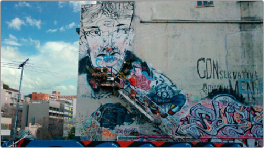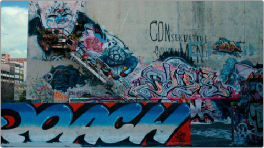

< Previous | Contents | Next >
Inverting the Strong parameter with a negative number to create matched motion
At this point, playing through the clip should result in a nicely matched correspondence between the movement of the foreground and background layers.


The background sky layer after it’s been matched to the motion of the foreground layer, the sky now follows along with the motion of the camera in the superimposed clip
Tracking and Stabilizing with the DaVinci Control Panel
All of the tracking commands are available via the DaVinci Resolve control panel.
![]()
— Press OBJECT TRACK MODE at the top of the T-bar panel.
— All of the tracking controls appear on the soft keys of the Center and T-bar panels.
— Use the TRACK FWD, TRACK REV, and STOP TRACK soft buttons on the left side of the Center panel.
— Press SHOW TRACK if you want to see the resulting motion path.
1 Press the P/T/Z/R ENABLE soft key. The middle four soft keys of the Center panel change to display PAN ON/OFF, TILT ON/OFF, ZOOM ON/OFF, and ROTATE ON/OFF.
2 Use these buttons to toggle any of these checkboxes on or off, then press BACK to go back to the other tracking controls.
1 Use the transport controls to move the playhead to the first frame you want to place a mark, and press MARK. A Viewer Mark appears on the tracking bar, identifying either the beginning or the end of the gap in that clip’s motion tracking data.
2 If necessary, use the transport controls to move the playhead to the second frame where you want to place a mark, and press MARK. A second Viewer Mark appears in the tracking bar, identifying both the beginning and end of the gap in that clip’s motion tracking data.
3 To perform the interpolation, do one of the following:
— If you marked both the first and last tracked frames that surround a gap in tracking data, press the INTRPLT BETWEEN soft key.
— If you marked the last tracked frame in the first half of the clip, then use the transport controls to move the playhead to the first tracked frame of the second half of the clip and press the INTRPLT REV soft key.
— If you marked the first tracked frame in the second half of the clip, then use the transport controls to move the playhead to the last tracked frame of the first half of the clip and press the INTRPLT FWD soft key.
— Press the CUE START, CUE LOWER, CUE UPPER, or CUE END soft keys on the T-bar panel.
1 Press the INTERACTIVE soft key at the left of the Center panel.
Additional button controls appear on the soft keys of the Transport panel, including INSERT (POINTS), DELETE (POINTS), CLEAR (POINTS), and SET POINT.
2 Do one of the following:
— To eliminate all tracking points, press the CLEAR soft key.
— To add a single tracking point, press CURSOR (above the fourth trackball), use the fourth trackball to position the onscreen cursor over the feature you’d like to add a tracking point to, and then press the SET POINT soft key.
![]()
— To eliminate a range of tracking points in order to prevent the tracking of an undesirable feature, use the mouse to draw a bounding box around the tracking points you want to remove, and press the DELETE soft key.
— To add a range of tracking points to a specific feature, use the mouse to draw a bounding box around the feature you want to track, and press the INSERT soft key.
3 Use the TRACK FWD, TRACK REV, and STOP TRACK soft buttons on the left side of the Center panel to perform the necessary tracking.
4 Press the INTERACTIVE soft key again to leave Interactive mode.